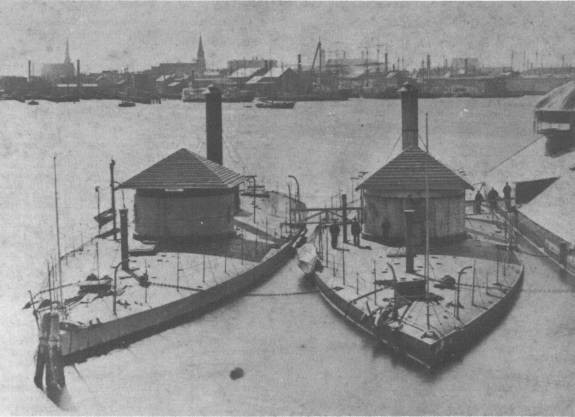Wassuc (CMc-3)

A mountain range in Nevada some 250 miles northwest of Las Vegas. Commonly spelled Wassuk, the term is of Paiute origin, and its meaning is unclear.
__________
(Mon.: dp. 1,175: l. 225'; b. 45'; dr. 6'; s. 9 k.; a. 2 11" D. sb.; cl. Casco)
Wassuc, a single-turreted, twin-screw monitor, was laid down in June 1863 at Portland, Maine, by George W. Lawrence & Co.; launched on 25 July 1865; and completed on 28 October 1865.
Wassuc was a Casco-class monitor intended for service in the shallow bays, rivers, and inlets of the Confederacy. These warships sacrificed armor plate for shallow draft and were fitted with a ballast compartment designed to lower them in the water during battle.
However, when the first ships of the class were launched in the spring of 1864, the Navy discovered that serious errors had been made in calculating their displacements. They proved to have barely three inches of freeboard-even without turret, guns, and stores. Therefore, the Navy Department ordered on 24 June 1864 that Wassuc's deck be raised 22 inches to provide sufficient freeboard. Upon delivery, the monitor was laid up at the Boston Navy Yard; and she saw no commissioned service. She was renamed Stromboli on 15 June 1869 but resumed the name Wassuc on 10 August 1869. Wassuc was sold for scrapping on 9 September 1875.
I
(CMc-3: dp. 1,830 (f.); l. 230'6"; b. 42'; dr. 10' (max.); s. 13 k.; cpl. 85; a. 1 3", 4 .50-cal. mg.; cl. Wassuc)
The first Wassuc (CMc-3), originally a steel-hulled, coastal passenger vessel built in 1924 at Elizabethport, N.J., by the New Jersey Drydock and Transportation Corp. of New York City as SS Yale, was acquired by the Navy on 20 December 1940. Yale then began conversion to a coastal minelayer at the New York Navy Yard. Classified CMc-3 on 30 December 1940 and renamed Wassuc on 10 January 1941, the ship was commissioned at the New York Navy Yard on 15 May 1941.
After commissioning, Wassuc proceeded south; touched at Norfolk; and then sailed back northward to the Washington Navy Yard where she arrived on 4 June. She subsequently moved to the Mine Warfare School at Yorktown, Va., on 23 June, where she relieved Cormorant (AM-40), freeing that minesweeper to begin an overhaul. During her service at Yorktown, Wassuc participated in experimental mine work under the aegis of the Bureau of Ordnance (BuOrd).
Completing that tour in mid-August, Wassuc moved to the Marine Basin at Brooklyn, N.Y., for extensive alterations that were not completed until after the Japanese attack on Pearl Harbor had plunged the United States into World War II. Two days after Christmas of 1941, Wassuc departed Tompkinsville, Staten Island, N.Y., bound for Yorktown to receive mine warfare instruction duties and further work under the auspices of BuOrd.
Wassuc spent the next two years operating in the 5th Naval District, primarily plying the waters of the Chesapeake Bay region and occasionally ranging as far north as the Washington Navy Yard and as far south as Cape Hatteras. She operated principally in BuOrd testing programs at the Naval Mine Warfare Proving Grounds at Solomon's Island, Md., and at Yorktown. She also served two tours of duty as a training ship, providing instruction for officers in the compensation of magnetic compasses. Although her duties appear to have been largely experimental and test-oriented, records indicate that the ship laid a small minefield off Cape Hatteras on 22 May 1942.
By 1944, Wassuc was the only coastal minelayer on the Navy inventory. The Army held primary responsibility for defensive coastal minelaying, and submarines and aircraft were proving superbly capable of carrying mine warfare to enemy shores. Nevertheless, Wassuc continued her undramatic but vital experimental and test work, far from the limelight of the far-flung battlefronts. She continued her coastwise routine, ranging from Provincetown, Mass., and Cape May, N.J., to New York and Norfolk, as well as Solomon's Island, through the end of World War II.
Decommissioned at the Norfolk Navy Yard on 8 November 1945 and struck from the Navy list on 28 November 1945, the Navy's last coastal minelayer was sold to the Patapsco Scrap Corp. on 3 August 1948 for scrapping.


